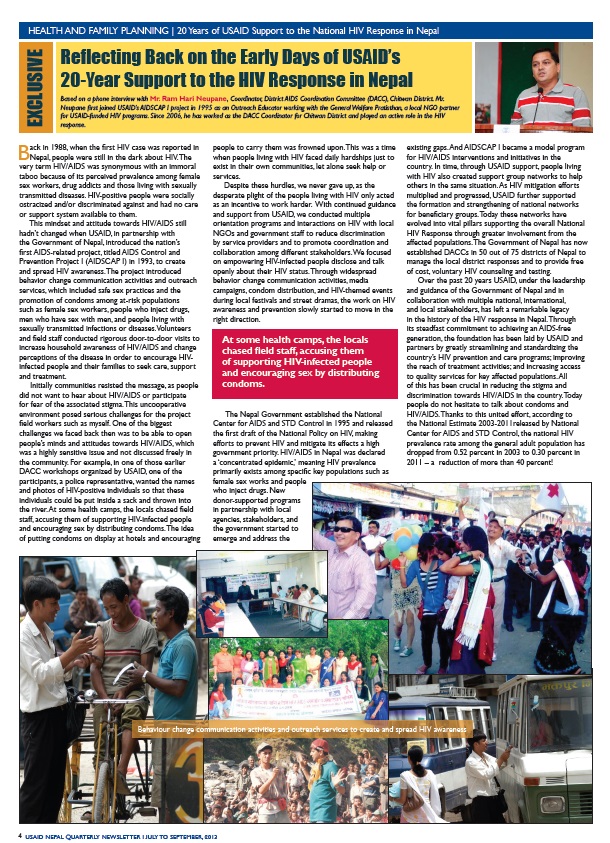Home » Reflecting Back on the Early Days of USAID’s 20-Year Support to the HIV Response in Nepal
Back in 1988, when the first HIV case was reported in Nepal, people were still in the dark about HIV. The very term HIV/AIDS was synonymous with an immoral taboo because of its perceived prevalence among female sex workers, drug addicts and those living with sexually transmitted diseases. HIV-positive people were socially ostracized and/or discriminated against and had no care or support system available to them.
This mindset and attitude towards HIV/AIDS still hadn’t changed when USAID, in partnership with the Government of Nepal, introduced the nation’s first AIDS-related project, titled AIDS Control and Prevention Project I (AIDSCAP I) in 1993, to create and spread HIV awareness. The project introduced behavior change communication activities and outreach services, which included safe sex practices and the promotion of condoms among at-risk populations such as female sex workers, people who inject drugs, men who have sex with men, and people living with sexually transmitted infections or diseases. Volunteers and field staff conducted rigorous door-to-door visits to increase household awareness of HIV/AIDS and change perceptions of the disease in order to encourage HIVinfected people and their families to seek care, support and treatment.
Initially communities resisted the message, as people did not want to hear about HIV/AIDS or participate for fear of the associated stigma. This uncooperative environment posed serious challenges for the project field workers such as myself. One of the biggest challenges we faced back then was to be able to open people’s minds and attitudes towards HIV/AIDS, which was a highly sensitive issue and not discussed freely in the community. For example, in one of those earlier DACC workshops organized by USAID, one of the
participants, a police representative, wanted the names and photos of HIV-positive individuals so that these individuals could be put inside a sack and thrown into the river. At some health camps, the locals chased field staff, accusing them of supporting HIV-infected people and encouraging sex by distributing condoms. The idea of putting condoms on display at hotels and encouraging people to carry them was frowned upon. This was a time when people living with HIV faced daily hardships just to exist in their own communities, let alone seek help or services.
Despite these hurdles, we never gave up, as the desperate plight of the people living with HIV only acted as an incentive to work harder. With continued guidance and support from USAID, we conducted multiple orientation programs and interactions on HIV with local NGOs and government staff to reduce discrimination by service providers and to promote coordination and collaboration among different stakeholders. We focused on empowering HIV-infected people disclose and talk openly about their HIV status. Through widespread
behavior change communication activities, media campaigns, condom distribution, and HIV-themed events during local festivals and street dramas, the work on HIV awareness and prevention slowly started to move in the right direction.
The Nepal Government established the National Center for AIDS and STD Control in 1995 and released the first draft of the National Policy on HIV, making efforts to prevent HIV and mitigate its effects a high government priority. HIV/AIDS in Nepal was declared a ‘concentrated epidemic,’ meaning HIV prevalence primarily exists among specific key populations such as female sex works and people who inject drugs. New donor-supported programs in partnership with local agencies, stakeholders, and the government started to emerge and address the existing gaps. And AIDSCAP I became a model program for HIV/AIDS interventions and initiatives in the country. In time, through USAID support, people living with HIV also created support group networks to help others in the same situation. As HIV mitigation efforts multiplied and progressed, USAID further supported the formation and strengthening of national networks for beneficiary groups. Today these networks have evolved into vital pillars supporting the overall National HIV Response through greater involvement from the affected populations. The Government of Nepal has now established DACCs in 50 out of 75 districts of Nepal to manage the local district responses and to provide free of cost, voluntary HIV counseling and testing.
Over the past 20 years USAID, under the leadership and guidance of the Government of Nepal and in collaboration with multiple national, international, and local stakeholders, has left a remarkable legacy in the history of the HIV response in Nepal. Through its steadfast commitment to achieving an AIDS-free generation, the foundation has been laid by USAID and partners by greatly streamlining and standardizing the country’s HIV prevention and care programs; improving the reach of treatment activities; and increasing access to quality services for key affected populations. All of this has been crucial in reducing the stigma and discrimination towards HIV/AIDS in the country. Today people do not hesitate to talk about condoms and HIV/AIDS. Thanks to this united effort, according to the National Estimate 2003-2011released by National Center for AIDS and STD Control, the national HIV prevalence rate among the general adult population has dropped from 0.52 percent in 2003 to 0.30 percent in 2011 – a reduction of more than 40 percent!
Date
Friday, November 22, 2013 - 4:00am








Comment
Make a general inquiry or suggest an improvement.